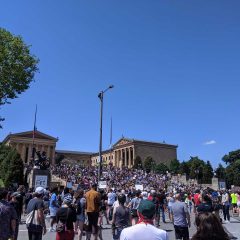Andrea Kirsh reports:
[This is the first of two posts by Andrea from Dublin. Part 2 is here.]
Dublin, Dec. 21-22, 2006

‘Signage for a 35 floor social center’ outside IMMA’s New Galleries by Liam Gillick
I was looking forward to my annual Christmas trip to Dublin because, in addition to seeing family, I was going to see two ambitious exhibitions of contemporary art. The Irish Museum of Modern Art (IMMA) announced an exhibition by 20 leading international artists based on the physical and conceptual processes involved in making and exhibiting art, including work by Doug Aitken, Douglas Gordon, Anri Sala, Rirkrit Tiravanija, Jorge Pardo and others. The exhibition was curated by the French artist Philippe Parreno and Rachel Thomas, IMMA’s Head of Exhibitions.
The conspicuously-incomprehensible title, .all hawaii eNtrees/luNar reGGae — turned out to be an anagram based on nothing more interesting than The New Galleries/ Na Galleraithe Nua, the English and Irish names for the exhibition space. That was a bad omen for an exhibition driven too much by ideas, with too little editing or sensitivity to its audience.
The first major challenge for the visitor was not deconstructing the relationship between individual artworks and the phenomenological effects of space and light, but simply identifying the works; labels were for entire rooms and listed artists’ names and titles of the pieces, but no medium. I found I had to ask the gallery attendants in each room, and that turned out to be the most interactive part of what was billed as an exhibition that suggested a model of sociability. The gallery staff was helpful and sympathetic, I must say; they had clearly been queried before.
Lambie seduces

Jim Lambie’s Zobop with two sculptures, Down Down and Soulstick
An exhibition that attempts to be this challenging also needs some obvious seduction, which too few pieces provided. One notable success was Jim Lambie’s Zobop, an installation of vinyl-taped stripes that flowed up the stairs, onto the landing, into the elevator and covered the floor of an adjacent room. I couldn’t figure out its connection with any of the proposed ideas behind the exhibition, but it transformed the space and engaged the visitor.
Sarah Morris’ documentary filmed portrait of the scriptwriter, Robert Towne, was equally of unclear relation to the proposed themes, but at least worked in the gallery, largely because the format of a talking head is the rare video that makes sense in an exhibition context where one can walk in at any point and catch a small part of a longer piece.
But other works were undermined by their installation. Fischli and Weiss’ The Way Things Go, is as appealing as it was in 1987, but it requires a place to sit. Visitors really will watch the entire 30 minutes of their jerry-rigged constructions which create a succession of minor household disasters — I was in the Tate Modern two just days earlier at the Fischli and Weiss retrospective , and many people stayed for the entire piece — but it was shown in a discrete space, and with benches. At IMMA it was shown on a monitor on the floor of a room with a Thomas Demand photograph and a window installation by Jorge Pardo. The juxtaposition did nothing for any of them.
A couple of the pieces I most wanted to see (or experience) had technical problems, so I can’t comment on either Tiravanija’s interactive environment or Aitken’s sound piece.
Aitken’s moving mirrors
Aitken’s other work, Wilderness, a wall-size construction of interlocking, hexagonal mirrors that moved slowly, was one of the exhibition’s most engaging. It had rather the look of a 1960s night-club interior and formal similarities to Jesus Raphael Soto’s work, but mirrors are always fun. The class of nine-year old schoolgirls being taken through the gallery certainly thought so.

The catalog’s cover, with its blurry print
The exhibit also came with lots of text – in the form of an 11-fold hand-out as well as a catalog which, according to the press release, Parreno considers of equal importance to the exhibition. The catalog, like the exhibit itself, offers some major challenges to the reader, with recalibrated images and blurred print supposedly contributing to an overall feeling of fluidity. That’s right — blurred print. The entire 221 page, full-color catalogue with essays by multiple authors was intentionally mis-printed so that every bit of it is blurred. It doesn’t produce an effect of fluidity, but of incipient cataracts. This might have seemed an interesting idea, but someone at the museum should have had the sense to remind the artist and curator that not all provocative ideas should be realized, and this was one of them. It came off as hostile to the audience, to the various contributing authors and the other artists. I’m amazed they all participated.
Hearth is homier
If IMMA’s major exhibition was a noisy failure, the smaller exhibition, Hearth, was a quiet success. It was a collaboration between the museum’s department of Education and Community Programs and the staff and clients of Focus, an organization that serves homeless women. Together they selected 16 works which reflected various ideas about home in contemporary Ireland. Not only did it make intelligent use of the museum’s own collections, but it confirmed the value of engaging in a significant dialogue with the museum’s broader community.

Vik Muniz’s Portrait of Alice Liddell
Some of the pieces, such as Paul Henry’s painted landscape, confirmed a traditional idea about domestic comfort. But not all of the artworks were either comforting or unambiguous. The first gallery contained Vik Muniz’s towering Portrait of Alice Liddell, after Lewis Carroll (2004), in which polychrome plastic toys, the detritus of a late, post-industrial childhood, were magically arranged to create the clearly-recognizable, poignant face of the Victorian child who inspired Alice in Wonderland.
Hereafter the deluge
Next to the Muniz was one of the most powerful pieces in the exhibition, Hereafter (2002) a black and white video by Paddy Jolley, Rebecca Trust and Inger Lisa Hansen. In the dark image one could just make out an abandoned domestic interior that crumbled as water leaks and then flowed down its walls, dislodging the wallpaper as objects fell through holes in the roof. After the tsunami in Southeast Asia and Hurricane Katrina, it spoke of generalized displacement in the face of disaster; but it turned out to have a particular and local resonance. It was shot in Ballymun’s tower blocks, famously-unsuccessful public housing in North Dublin which were torn down (as was the contemporaneous Pruitt-Igoe housing project in St. Louis, which was torn down in 1972). Its residents were offered new homes, but the move destroyed their already fragile community.

Dimitri Tsykalor’s Chalet/Shed (2003)
Dimitri Tsykalor’s Chalet/Shed (2003), was a life-sized sports-car constructed entirely of knotty-pine, its interior fitted out as a bed complete with plaid blanket, reading lights and a clock/radio. While the comfortable domesticity of the neatly-made bed was playful, it also hinted at the darker side of sleeping in cars by people with no fixed abode.

Property, by Beate Klein and Hendrijke Kuhn
A large floor installation by Beate Klein and Hendrijke Kuhn also interwove play and fantasy with darker colors. They created a miniature city entirely out of images of houses advertised in the Irish Times over a one-year period. They pasted all the cut-out pictures to cardboard, with slotted cross-pieces to make them stand up. Their miniature city consists of houses sold during a period of unprecedented inflation in Dublin’s housing, in which some people made their fortunes, but many were priced out of the market.
[Go to Part 2]
–Andrea Kirsh is an art historian living in Philadelphia. See her Philadelphia Introductions essays on emerging artists at inliquid.









